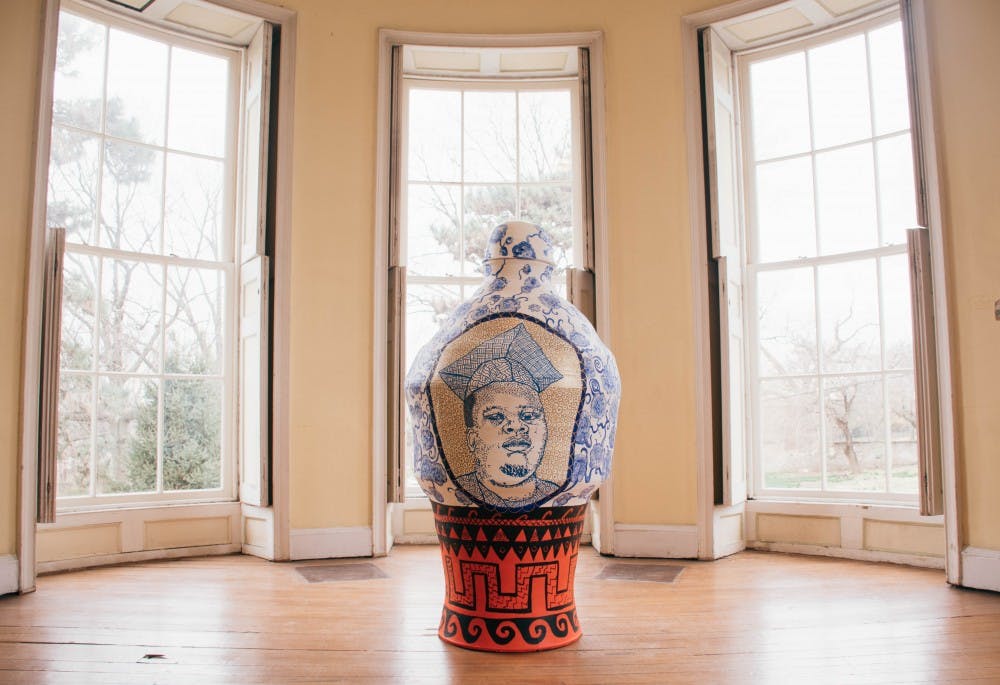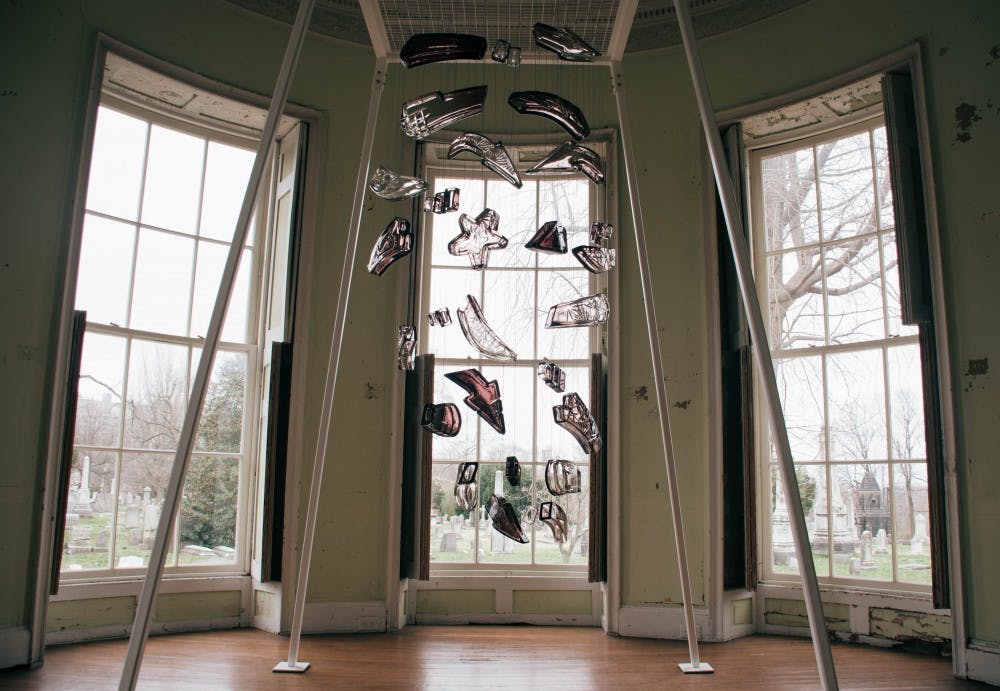In an old Philadelphia mansion hangs sculptural glass and neon lights. Graffiti–covered ceramics and large self–portraits recall hidden histories. Through open windows, visitors overlook an undulating green cemetery: graves from the mid–18th century side by side with the graves from today. The past and the present intermingle, overlapping and intertwined.
The Woodlands in West Philadelphia presents Graffiti & Ornament, an exhibition of site–specific works by artists Roberto Lugo and Leo Tecosky. Held in the historic Hamilton’s Mansion, not twenty minutes from Penn's campus, Graffiti & Ornament, according to the website, “shed[s] new light on the historic interior of the Hamilton Mansion at the Woodlands, connecting Philadelphia’s past to its present in unexpected ways.”
Graffiti & Ornament places contemporary sculptural works throughout Hamilton’s Mansion, and provides attendees with a map of the artworks within the space. Rooms are filled with large, graffitied ceramics and multicolored, suspended glass. The objects are not crowded together—each has a special space and relative position to the other art pieces and the broader surroundings of The Woodlands and Hamilton’s Mansion.
Artist Roberto Lugo was born in Philadelphia’s Kensington neighborhood. A self–titled “ghetto potter,” as noted on the exhibit's website, Lugo’s work “bears witness to histories that have often been excluded, and as a result, reshapes the narrative of ceramics.” In addition, the site details how Lugo creates space for new identities in relation to traditional ceramics by "insert[ing] his Puerto Rican heritage, and his personal and cultural heroes into the work. Lugo’s work bears witness to histories that have often been excluded, and as a result, reshapes the narrative of ceramics. Graffiti often becomes the ornament on his vessels, which depict portraits that range from hip-hop stars the Wu-Tang Clan, to poet Gwendolyn Brooks."
For Graffiti & Ornament, the website's introduction continues, Lugo crafted vessels “to memorialize those from his Kensington community, echoing the wooded cemetery that surrounds Hamilton’s Mansion.” As an exhibit sign notes, in a large ceramic piece entitled Do you know how hard it is to get a black man through high school? (2019), Lugo “depicts the fallen youth Michael Brown on one side and the artist on the other. In their physical similarities, Lugo confronts their different life outcomes.” Opposite the ceramic vessel stands Jarring: What’s Within (2019), a resin sculpture cast from the artist’s body. The pieces, in conversation with one another and with the Mansion and cemetery surroundings, act as a deeply personal response to systemic racial violence, placing art in the context of institutional histories.

Artist Leo Tecosky’s sculptural glass and neon pieces for Graffiti and Ornament, according to the website, “create a multifaceted homage to his grandmother Evelyn Rose Tecosky (1925–2017), a lifelong Philadelphia resident whose Depression glass collection inspired the artist’s own work in glass.” In Ev (2019), the exhibit plaques note, Tecosky memorializes his grandmother’s name into repeating sculptures, “using neon to reflect the ephemeral mark of graffiti tagging.” Tecosky’s work is poignant and honest, reflecting The Woodlands’ gravesite surroundings, reminding viewers that each grave marks a loved one lost. As exhibit signs detail, in Nostalgia Styles (2019), Tecosky “recall[s] childhood memories of his grandmother’s glass.” Like Lugo, Tecosky makes personal work, reminders of the importance of history and memory. The exhibit descriptions highlight glass’ ability to transmit light, drawing the admirer's eye to how Nostalgia Styles “is sited near the mansion’s celebrated bay windows, building a material connection between past and present.” In bridging the then and now, Tecosky permits viewers to celebrate memory.

In showing Lugo’s and Tecosky’s works at Hamilton’s Mansion, Graffiti & Ornament consciously examines Philadelphia’s present relationship to its past. Built and restored in the late 18th century, Hamilton’s Mansion, according to the site, “contains one of the preeminent neoclassical interiors in the United States, boasting what were likely the best–finished and most sophisticated internal service spaces created at that time in Philadelphia, and perhaps the country as a whole.” In its day, the website continues, the Mansion “offered a setting for both formal and informal entertainment, the display of art, and high-style day–to–day living.” Through bringing two contemporary artists “who embrace graffiti and hip–hop culture within their artistic practice” to a historical mansion, the website concludes, Graffiti & Ornament challenges preconceptions regarding high art.
Graffiti & Ornament runs March 31–April 28, 2019.

